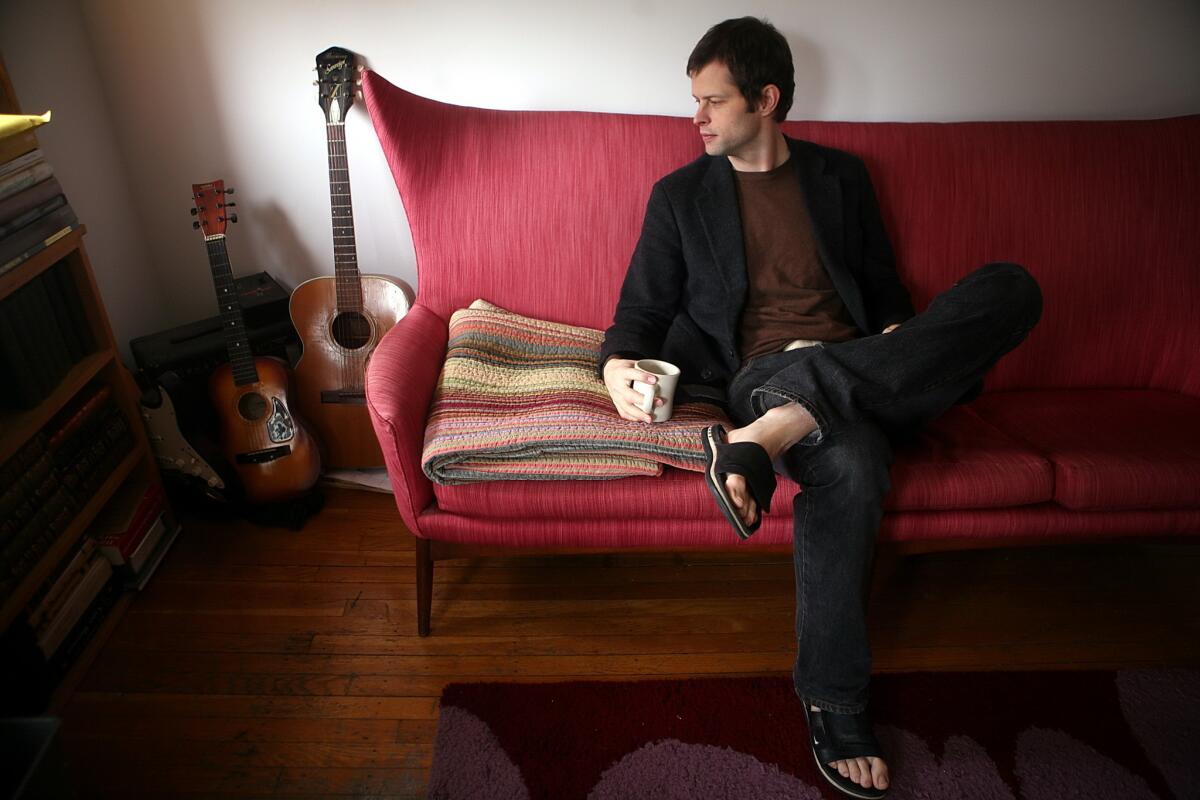Review: In ‘The Lost Time Accidents,’ John Wray balances the logical and the ludicrous

Author John Wray at his home in Brooklyn on March 10, 2009.
- Share via
“Chronology is an illusion, if not a deliberate lie,” a character posits in “The Lost Time Accidents,” the fourth offering from novelist John Wray. “The steady, one-way current we seem to be suspended in is actually a jumble of spherical ‘chronocosms’ that can be moved through in any direction, if some great force manages to knock one’s consciousness out of its preconditioned circuit.”
If you’re not quite sure what all that means, never fear. The fine line between hokum and rational thinking is precisely the point of “The Lost Time Accidents”; a brick of a book not just because of its length but because of the density of both the prose and the ideas it contains.
It is, in a nutshell, a sweeping historical novel that’s also a love story but is rooted in time-travel science fiction and takes on as its subject the meaning of time itself. This is no small endeavor. It’s hard not to admire this book, the mass and richness of which is a testament to the meticulous, dedicated work of its talented author. But it’s also not easy to love it.
The narrator of “The Lost Times Accidents” is Waldy Tolliver, a college dropout with oddly antiquated mannerisms who has holed up in a cluttered Spanish Harlem apartment belonging to his recently deceased aunts. He has somehow found himself “exiled” from time and is desperate to find his way back. The novel alternates between a letter the forlorn Tolliver is writing to an ex-girlfriend whom he refers to only as “Mrs. Haven” and the family history that he is laboriously penning. (That is, when he is not being haunted by his dead — or possibly also stuck-in-time — Nazi great-uncle.)
Tolliver’s family, we quickly learn, is obsessed with something called the “Lost Time Accidents”: Supposedly the secret to time travel which his great-grandfather Ottokar Toula — a pickle merchant and amateur physicist in early 20th century Moravia — concealed in a cryptic rhyme before inconveniently dying. The following generations — including Ottokar’s sons, Waldemar and Kaspar, in prewar Vienna; and reclusive twin granddaughters, Enzian and Gentian, in modern Cheektowaga, N.Y. — grow fixated with solving the puzzle he left behind.
Waldy’s central motivation is a sort of Tarantino-esque historical revenge fantasy: He’s out to locate his great-uncle Waldemar, with whom he shares both a name and time-traveling abilities, and punish him for the crimes he perpetrated in concentration camps. (Think “Kill baby Hitler!”) Meanwhile, there’s a mysterious cult called the United Church of Synchronology, founded on the nonsense that Waldy’s father, Orson (a pulp sci-fi writer of some success), spouts in his books and which appears to be stalking Waldy. And is the elusive Mrs. Haven part of a grand conspiracy, out to destroy our narrator?
No, nothing about this book is simple or direct: It’s like a wriggling fish, maddeningly hard to pin down but fascinating to observe.
The novel takes as its hypothesis that “time and space themselves are in transit, subject to a motion both pliable and absolute, and that man can influence said motion by an act of focused, virtuosic will.” This is utterly specious nonsense, of course, and one of the great delights of “The Lost Time Accidents” is how meticulously Wray advances this pseudoscience, to the point where it’s almost convincingly real. Mixed in with the mumbo-jumbo about the “timestream” and “autosuggestive psychostasis” and “exclusion bins” are philosophies and physics from a boggling number of thinkers: St. Augustine, Ouspensky, Newton, Wittgenstein, Blake, Lamarck; the physics of Michelson-Morley and Heisenberg and Einstein.
Wray’s essentially attempting a tightrope-walk between the logical and the ludicrous, a balletic exploration of the meaning of time and memory and consciousness, that embraces both the science and the fantasy of it all. In this, he succeeds.
It’s the other parts of the book, the plot and characters, that lose their balance. The structure of the book — bouncing nonlinearly among the past, the near-past and the present — is frustratingly complex, to the point where it’s nearly impossible to grasp the storyline. Characters often come off less as people than as a collection of eccentricities: They have names like Wilhelm Knarschitz and Nayagünem Menügayan, and no one is allowed to walk around without some bizarre accessory — say, a meerschaum pipe or a duck-shaped wicker basket. (Wray’s women, in particular, bear little to no resemblance to fathomable human beings, which is perhaps why the book’s love relationships mostly fall flat.)
Wray’s prose is breathtakingly evocative, like when he describes prewar Vienna: “Anti-Semitism hung in the air like smoke in those years, like the musk of the horse-drawn fiakers; and the Viennese inhaled it with each breath.” Or contemporary New York City: “I discovered features of the city that I might otherwise never have noticed: the fractal array of streets in the financial district, for example, or the disembodied tang of styling gel on certain Chinatown streetcorners, or the charged, lysergic flatness of midtown office towers in the minutes before sunrise.”
But his writing style can also be distractingly formal and mannered, especially once we leave Vienna and arrive in America. Nothing is simply expressed — the urge to urinate, for example, is described as “a discomfort in my lower body — a sort of roiling muscular impatience — with its focus at the buckle of my belt.” Characters communicate through coded riddles and secret messages; they write pulp fiction with titles “BIEHXIXHEIB” and “The Principatrix of Gnawledge” and the narrative is littered with words like “scrofulous” and “querelophone.”
At moments, all this is delightfully ridiculous, reminiscent of Michael Chabon at his madcap best. But 500 dense pages in, so much precocious quirk gets exhausting, like an overdone Wes Anderson film.
Still, it’s hard to resist the joy in this book. You get the sense that Wray had a blast writing it, creating (as his narrator puts it) “whole cosmologies out of nothing but [their] own enthusiasm.” “The Lost Time Accidents” often feels like a kind of authorial fever dream, at times brilliant, at times utterly impenetrable, but always altogether unique.
Brown is the author of the novel “This Is Where We Live.”
::
The Lost Time Accidents
By John Wray
Farrar, Straus and Giroux: 512 pp., $27
More to Read
Sign up for our Book Club newsletter
Get the latest news, events and more from the Los Angeles Times Book Club, and help us get L.A. reading and talking.
You may occasionally receive promotional content from the Los Angeles Times.






